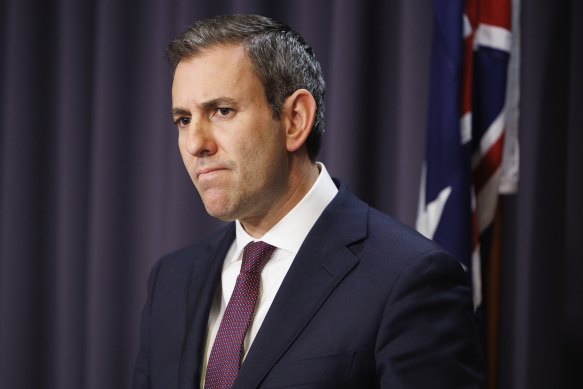
Want to save the budget? Ditch the franking credits loophole
Towards the end of last month, amid bubbling concerns over a global recession and fears about Australia’s national debt, the government announced a change to the country’s $43 billion franking credits system.
Emphatically stressed by Treasurer Jim Chalmers as “very minor”, the change would affect only companies paying fully franked dividends funded by capital raisings. It would save the budget a modest $10 million a year, and was “nothing like” Labor’s famously ill-fated 2019 election pitch.
Treasurer Jim Chalmers stressed Labor’s new policy was nothing like its 2019 pitch. More’s the pity.Credit:Alex Ellinghausen
Regardless, the usual spectres were out in force warning the government against meddling with franking credits, as if the mere suggestion of changing a tax system that hands out billions in ‘extra’ dividends to overwhelmingly wealthy investors was a mortal sin.
But Labor’s only sin was not going far enough. Excess franking credits deserve to be axed.
If you’re someone whose eyes glaze over when franking credits are mentioned, let me give you a quick breakdown: companies pay their shareholders dividends from their yearly profits. Those dividends are taxed at 30 per cent (25 per cent for small businesses).
However, the payment of the dividend to an individual shareholder would also be taxed at that shareholder’s marginal tax rate. Therefore, in 1987, the government introduced the franking credit system to remove this “double taxation” effect.
This means investors who are paid franked dividends can claim a credit from the tax office which reflects the tax the company already paid on the dividend. Often these credits mean investors don’t pay any income tax at all, and, if the credits exceed their tax bill, even receive a refund.
In theory, removing double taxation sounds like a good idea. In practice, it has increasingly been used as a fillip for older investors whose income comes from their superannuation and is therefore tax-free. So – despite paying no income tax – due to these credits they still receive thousands of dollars in refunds from the ATO.
Compounding this is the fact franking credits are overwhelmingly paid to already wealthy Australians – data from 2015 shows nearly 75 per cent of franking credits go to Australia’s top 10 per cent of income earners, and 17 per cent of all franking credits go to literal millionaires. Australia is the only country in the OECD to offer such a generous scheme.
The Australian Council of Social Service (ACOSS) in 2019 supported Labor’s proposal, saying it was a “fair way to raise public revenue for essential services” and noting that those affected by the policy could largely afford to pay.
For someone like myself – 26 years old with almost no investments to speak of – widespread reform of investing loopholes that overwhelmingly benefit the nation’s wealthiest seems to be a no-brainer, especially at a time when the budget is in dire need of extra savings.
Labor’s 2019 policy estimated axing these excess credits could generate $5.3 billion a year, with some forecasts saying that could stretch to $35 billion per year over time.
Think of what could be funded if even just a portion of those savings were realised. The Greens’ proposal for completely free childcare and early education was costed at $19 billion over three years which could be easily funded by the end of excess franking credits. In the current cost of living crisis, the savings of such a policy for families would be immense, not to mention the multi-billion dollar boon to the nation’s GDP that would come from the increased productivity.
Opponents of such a change argue it would unfairly impact pensioners and other elderly Australians who rely on franking credit income to survive. Labor’s original policy excluded recipients of income support payments, and ACOSS suggests this should be further refined to be a fixed annual income threshold, both sensible suggestions that should be preserved.
Savings from axing excess franking credits could be funnelled into Australia’s under-resourced aged care sector.
Savings from abolishing the policy could also be used on social services, such as health and aged care, moves which would further benefit those who may be most affected by the removal of excess credit refunds.
Matt Grudnoff, a senior economist at the Australia Institute think tank who has authored numerous reports on the scheme, thinks Labor’s 2019 policy is still a good one and could be brought back with the appropriate campaigning.
“It requires the government to sit down and have a conversation with people about what excess franking credits are, who’s benefiting from them, and carefully explain who it’s not going to impact,” he said.
“We’re the only country in the developed world that has this kind of policy, it’s insanely generous, and it doesn’t make any sense. If you don’t pay any tax, why should you have a tax refund?”
But reintroducing such a policy would require Labor to both embark on “real” tax reform and face the inevitable “retiree tax” line the opposition would gleefully reheat, two battles it seems unwilling to fight.
The Business Briefing newsletter delivers major stories, exclusive coverage and expert opinion. Sign up to get it every weekday morning.
Most Viewed in Money
From our partners
Source: Read Full Article

